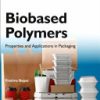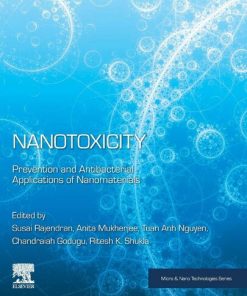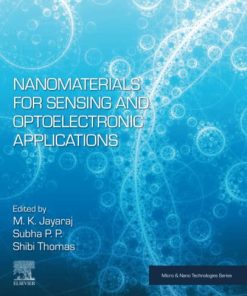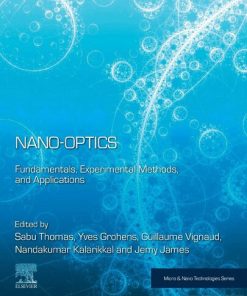Nanocosmetics Fundamentals Applications and Toxicity 1st edition by Arun Nanda, Sanju Nanda, Tuan Anh Nguyen 0128222850 9780128222850
$50.00 Original price was: $50.00.$25.00Current price is: $25.00.
Nanocosmetics: Fundamentals, Applications and Toxicity 1st edition by Arun Nanda, Sanju Nanda, Tuan Anh Nguyen – Ebook PDF Instant Download/DeliveryISBN: 0128222850, 9780128222850
Full download Nanocosmetics: Fundamentals, Applications and Toxicity 1st edition after payment.
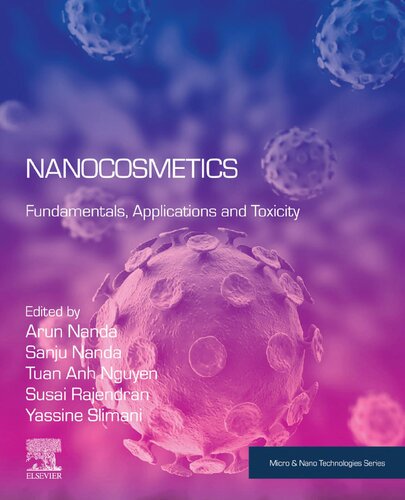
Product details:
ISBN-10 : 0128222850
ISBN-13 : 9780128222850
Author : Arun Nanda, Sanju Nanda, Tuan Anh Nguyen
Nanotechnology is key to the design and manufacture of the new generation of cosmetics. Nanotechnology can enhance the performance and properties of cosmetics, including colour, transparency, solubility, texture, and durability. Sunscreen products, such as UV nano-filters, nano-TiO2 and nano-ZnO particles, can offer an advantage over their traditional counterparts due to their broad UV-protection and non-cutaneous side effects. For perfumes, nano‐droplets can be found in cosmetic products including Eau de Toilette and Eau de Parfum.
Nanomaterials can also be used in cosmetics as transdermal drug delivery systems. By using smart nanocontainers, active compounds such as vitamins, antioxidants, nutrients, and anti-inflammatory, anti-infective agents, can be delivered effectively. These smart nanocontainers are typically related with the smart releasing property for their embedded active substances. These smart releases could be obtained by using the smart coatings as their outer nano-shells. These nano-shells could prevent the direct contact between these active agents and the adjacent local environments.
Nanocosmetics: Fundamentals, Applications and Toxicity explores the formulation design concepts and emerging applications of nanocosmetics. The book also focuses on the mitigation or prevention of their potential nanotoxicity, potential global regulatory challenges, and the technical challenges of mass implementation. It is an important reference source for materials scientists and pharmaceutical scientists looking to further their understanding of how nanotechnology is being used for the new generation of cosmetics.
Nanocosmetics: Fundamentals, Applications and Toxicity 1st Table of contents:
1 Basic principles
1 Nanocosmetics: an introduction
1.1 Introduction
1.2 Consumer requests and cosmetics
1.3 Polymers, nanocomposites, and nonwoven tissues
1.4 Conclusive remarks
1.4.1 Micro/nanoemulsions
1.4.2 Packaging material
References
2 Transdermal and bioactive nanocarriers
Abbreviations
2.1 Introduction
2.2 Skin
2.2.1 Epidermis
2.2.2 Dermis
2.2.3 Dermis–epidermis junction
2.2.4 Hypodermis
2.3 Transdermal delivery
2.4 Evolution of transdermal delivery
2.5 Development of transdermal delivery in cosmetics
2.6 Advantages of transdermal delivery
2.7 Components of transdermal patch
2.7.1 Polymer matrix
2.7.2 Biologically active substances
2.7.3 Permeation enhancers
2.7.4 Adhesive
2.7.5 Backing laminate
2.7.6 Release liner
2.7.7 Other excipients
2.8 Novel technologies toward the development of the transdermal system
2.8.1 Iontophoresis
2.8.2 Electroporation
2.8.3 Microneedles
2.8.4 Microdermabrasion
2.8.5 Laser radiation
2.9 Bioactive nanocarriers
2.9.1 Liposomes
2.9.2 Niosomes
2.9.3 Solid lipid nanoparticles
2.9.4 Nanoemulsions
2.9.5 Nanostructured lipid carriers
2.10 Discussion
2.11 Conclusion
Acknowledgments
References
3 Transdermal and bioactive nanocarriers for skin care
3.1 Introduction
3.2 The skin
3.3 Nanocarriers and skin penetration
3.4 Nanocarrier system
3.4.1 Liposomes and related particles
3.4.2 Solid lipid nanocarriers and structured lipid nanocarriers
3.4.3 Nano- and microemulsions
3.4.4 Inorganic nanocarriers
3.4.5 Dendrimers and other dendritic structures
3.4.6 Other polymeric nanoparticles
3.4.7 Polysaccharide nanocarriers
3.5 Conclusions and future perspectives
References
4 Nanoemulsions for cosmetic products
4.1 Introduction
4.2 Emulsion delivery systems in cosmetics
4.2.1 Emulsion generalities
4.2.2 Microemulsions and nanoemulsions—aren’t both nanosystems?
4.3 Formulation and production of nanoemulsions
4.4 Characterization of nanoemulsions
4.5 Why nanoemulsions in cosmetics?
4.5.1 Skin care
4.5.2 Hair care
4.6 Challenges and future perspectives
References
5 Nanomaterials for cosmeceuticals: nanomaterials-induced advancement in cosmetics, challenges, and
5.1 Introduction to nanotechnology
5.2 Nanotechnology is multidisciplinary field
5.3 Historical perspective of nanotechnology in cosmetics
5.4 Nanotechnology-based cosmetics
5.4.1 Liposomes
5.4.2 Nanoemulsions
5.4.3 Niosomes
5.4.4 Solid lipid nanoparticles
5.4.5 Nanocapsules
5.4.6 Nanocrystals
5.4.7 Gold and silver nanoparticles
5.4.8 Dendrimers
5.4.9 Cubosomes
5.4.10 Nanomedicine
5.4.11 Hydrogels
5.4.12 Fullerenes/Buckyballs
5.4.13 Polymersomes
5.4.14 Carbon nanotubes
5.4.15 Nanostructured lipid carriers
5.4.16 Nanospheres
5.5 Major classes of nanocosmeceuticals
5.5.1 Nail care
5.5.2 Lip care
5.5.3 Skin care
5.5.4 Hair care
5.6 Challenging aspects
5.6.1 Human health insecurities
5.6.1.1 Routes of exposure
5.6.1.1.1 Inhalation
5.6.1.1.2 Ingestion
5.6.1.1.3 Dermal routes
5.6.2 Ecological hazardous issues
5.7 Future prospects and opportunities
References
6 Polymeric nanocarriers for topical drug delivery in skin cream
6.1 Introduction
6.2 Materials and methods
6.2.1 Materials
6.2.2 Formulation design
6.2.2.1 Factorial design experiment
6.2.2.2 Formulation of PCL polymeric nanocarriers
6.2.2.3 Formulation of cream
6.2.3 Characterizations
6.2.3.1 Characterization of polymeric nanocarriers
6.2.3.2 Evaluation of cream containing the saffron-loaded polymeric nanoparticles
6.3 Results and discussion
6.3.1 Evaluation of saffron-loaded polymeric nanoparticles
6.3.1.1 Factorial design for the formulation of polymeric nanocarriers
6.3.1.2 Measurements of particle size and zeta potential
6.3.1.3 Entrapment efficiency
6.3.1.4 Morphological studies
6.3.1.5 Anti-oxidant activity
6.3.1.6 Anti-inflammatory activity
6.3.2 Evaluation of cream formulation
6.3.2.1 In vitro dissolution studies
6.3.2.2 Release kinetics
6.4 Conclusion
References
7 Organic UV filter loaded nanocarriers with broad spectrum photoprotection
7.1 Introduction
7.2 Protection filters
7.3 Conventional products for sun protection
7.4 Nanocarriers for sun protection
References
8 Cosmetic nanoformulations and their intended use
8.1 Introduction
8.2 Nanocarriers/nanomaterials in cosmetics
8.2.1 Liposomes
8.2.2 Nanoemulsions
8.2.3 Solid lipid nanoparticles
8.2.4 Nanostructured lipid carriers
8.2.5 Cubosomes
8.2.6 Nanosponges
8.2.7 Dendrimers
8.2.8 Nanosilver
8.2.9 Nanogold
8.2.10 Nanospheres
8.2.11 Carbon nanotubes
8.2.12 Nanopigments/nanoparticles
8.3 Categories of nanotechnology-based cosmetics
8.3.1 Skin care
8.3.1.1 Sunscreens
8.3.1.2 Antiaging creams
8.3.1.3 Moisturizers
8.3.1.4 Skin cleansers
8.3.2 Lip care
8.3.3 Oral care
8.3.3.1 Toothpastes
8.3.3.2 Mouth wash
8.3.3.3 Hair care
8.3.4 Nail care
8.4 Consumer concerns and regulatory guidances
8.4.1 Routes of nanocosmetics exposure
8.4.2 European Union Guidelines
8.4.3 Guidance document issued by FDA for industries
8.4.3.1 Safety assessment of nanomaterials in cosmetic products
8.4.3.2 Primary considerations to assess the safety of nanomaterials in cosmetic products
8.5 Conclusion
References
Further reading
2 Emerging applications
9 Water-based nanoperfumes
9.1 Introduction
9.2 Water-based or/and alcohol-free perfumes
9.3 Nanodispersions as a carrier for fragrances
9.4 The advantage of nanoemulsions over microemulsions
9.5 Conclusions
References
10 Nanocosmetics for broadband light protection sun care products
10.1 Introduction
10.2 Visible light: should we protect ourselves?
10.2.1 Interaction of visible light with the skin
10.2.2 Effects of visible light on the skin
10.2.2.1 Photosensitizer and photosensitization reactions
10.2.2.2 Reactive species generation in skin cells irradiated with visible light
10.2.2.3 Photodamage in biomolecules and organelles caused by sunlight
10.3 Functional analysis methods to detect solar damage
10.4 Strategies for protection from visible light
10.4.1 Filters
10.4.1.1 Nanoparticles
10.4.1.2 Nanocarriers
10.4.2 Membrane protection
10.4.3 Antioxidants
10.5 Final remarks
References
11 Nanomaterials for hair care applications
11.1 Introduction
11.2 Hair structure
11.2.1 Hair shaft
11.2.2 Hair follicles
11.3 Nanostructured systems for hair treatment
11.3.1 Types of nanostructured systems
11.3.1.1 Liposomes
11.3.1.2 Cyclodextrins
11.3.1.3 Dendrimers
11.3.1.4 Polymeric nanoparticles
11.3.1.5 Metallic nanoparticles
11.3.1.6 Nanocrystals
11.3.1.7 Solid lipid nanoparticles and nanostructured lipid carriers
11.3.1.8 Nanoemulsions
11.3.2 Hair treatment
11.3.2.1 Hair damage
11.3.2.2 Hair graying
11.3.2.3 Alopecia
11.3.2.4 Antidandruff
11.4 Future perspectives
Acknowledgments
References
12 Nanoparticles in hair dyes
12.1 Human hair
12.1.1 Function of human hair
12.1.2 Chemical composition of hair
12.1.3 Living being found in human hair
12.1.4 Three major components of the hair shaft
12.1.5 Anatomy of human hair
12.2 Hair colors
12.3 Melanins
12.4 Building blocks of eumelanins and pheomelanins
12.5 Parkinson’s and Alzheimer’s diseases
12.6 Gray hair
12.7 Plucking gray hair is bad
12.8 Natural turning of gray hair into black hair
12.9 Composition of hair dyes in olden days
12.10 Common chemicals used in hair dyes
12.11 Harmfulness of hair dyes
12.12 Side effects of the chemicals used in common hair dyes
12.13 Toxic chemicals in hair dye
12.14 Graphene hair dye
12.15 Gold nanoparticles as hair dye
12.16 p-Phenylenediamine-incorporated nanoparticles as hair dye
12.17 Tips for faster growth of hair
12.18 Best foods to promote hair growth
12.19 Fruits for hair growth
12.20 Recent research on the use of nanoparticles in hair dyes
12.20.1 Estimation of nanoparticles’ human skin penetration in vitro by confocal laser scanning mi
12.20.2 Phototherapy and multimodal imaging
12.20.3 Assembly of polymer-grafted proteins
12.20.4 Detection of zinc in human hair by self-assembled NPs
12.20.5 Penetration of nanocarriers into the hair follicles
12.20.6 Lipid nanoparticles for follicular targeting
12.20.7 Nanoparticles-based formulation for hair follicle targeting
12.20.8 Nanoparticles as a gene (or drug) carrier to the inner ear
12.20.9 Hair-dye assay using graphene/ionic liquid electrochemical sensor
12.20.10 A targeted approach for the treatment of psoriasis using polymeric micelle nanocarriers
12.20.11 Quantification of nanoparticle uptake into hair follicles in pig ear and human forearm
12.20.12 Presentations in conferences
12.20.13 Polymeric nanoparticles-embedded organogel for roxithromycin delivery to hair follicles
12.20.14 Permanent hair dye-incorporated hyaluronic acid nanoparticles
12.20.15 Hair fiber as a nanoreactor in controlled synthesis of fluorescent gold nanoparticles
12.20.16 Hair dye-incorporated poly-γ-glutamic acid/glycol chitosan nanoparticles based on ion-comp
12.20.17 Translocation of cell penetrating peptide engrafted nanoparticles across skin layers
12.20.18 Safety assessment of personal care products/cosmetics and their ingredients
12.20.19 Potential novel drug carriers for inner ear treatment: hyperbranched polylysine and lipid n
12.20.20 Investigation of polylactic acid nanoparticles as drug delivery systems for local dermatoth
12.20.21 Nanoparticles—an efficient carrier for drug delivery into the hair follicles
12.20.22 In vivo drug screening in human skin by femtosecond laser multiphoton tomography
12.21 Concluding remarks
References
13 Nanomaterials in fragrance products
13.1 Introduction
13.2 Nano-ingredients
13.3 Home fragrance products
13.3.1 Astonishing ways to make your home smell amazing
13.3.2 Use of orange peels in making your house smell good
13.3.3 Tips to keep a kitchen smelling so fresh
13.3.4 Toilet freshener
13.3.5 Fragrance for body
13.4 Natural fragrances
13.5 Fragrance affects your skin
13.6 Chemicals present in fragrance
13.7 Ingredients to be avoided in skin care
13.8 Parabens
13.9 Nanotechnology in perfumes
13.10 Applications of nanotechnology in perfumes
13.10.1 Production of perfume (aroma) compounds
13.10.2 Time-controlled and prolonged release of scents
13.10.3 Use of nanoencapsulation procedures in development of nanotechnology
13.10.4 Probable risks of nano-based perfumes
13.10.5 High tech of small serving giant thrills with giant threats
13.11 Sunscreen
13.11.1 Uncoated zinc oxide
13.11.2 Use of titanium dioxide as sunscreen
13.12 Recent trends in research on electronic noses, nanoparticles, and fragrant products
13.12.1 Titanium dioxide nanoparticle-based indoor antiodor product
13.12.2 Electronic noses in meat quality assessment
13.12.3 Flavor of traditional soup of Chinese Yellow-Feather Chickens
13.12.4 Odor intensity assessment
13.12.5 Computer-controlled odor generator
13.12.6 Nanoparticle-enzyme sensors for detection of bacteria with olfactory output
13.12.7 Recognition of Chinese Herbal Medicines with electronic nose technology
13.12.8 Area identification of Zhongning Goji berries by an electronic nose
13.12.9 Assessment of the indoor odor impact in a naturally ventilated room
13.12.10 Odor standardization by bioelectronic noses
13.12.11 Comparison of volatile fraction of vodkas made from different botanical materials by electr
13.12.12 Olfaction as a soldier
13.12.13 Aromatic wallpaper
13.12.14 Bioelectronic noses
13.12.15 A bioelectronic sensor using human olfactory and taste receptors
13.12.16 Fragrance profiling of Jasminum Sambac Ait. flowers using electronic noses
13.12.17 Evaluation of an electronic nose for odorant and process monitoring of alkaline-stabilized
13.12.18 Electronic nose to detect freshness of eggs
13.12.19 Verification of odorants in rose
13.12.20 Predicting the growth situation of Pseudomonas aeruginosa on agar plates and meat stuffs us
13.13 Future perspectives
References
14 Natural polymers for natural hair: the smart use of an innovative nanocarrier
14.1 Introduction: the hair system
14.2 Hair structure and damage
14.3 Cosmetic hair care treatments
14.4 Natural fibers for natural hair
14.4.1 Polysaccharides
14.4.2 Chitin
14.5 Chitin and hair: final considerations
References
15 Skin and pollution: the smart nano-based cosmeceutical-tissues to save the planet’ ecosystem
15.1 Introduction
15.2 Skin aging
15.3 Inflammaging and oxidative stress
15.4 Life expectance and cosmetic treatments
15.5 Air pollution, waste, and human health
15.6 Innovative smart cosmeceutical-tissues
15.7 Extracellular matrix and active ingredients
15.8 Conclusive remarks
Aknowledgments
Conflicts of interest
References
16 Nanocarrier-mediated follicular targeting
16.1 Introduction
16.2 The barrier characteristics of human skin
16.3 Penetration pathways across the skin
16.4 The rationale behind nanocarrier-mediated follicular targeting
16.5 The role of hair follicles in nanocarrier-mediated skin delivery
16.5.1 Follicular ducts as reservoirs of nanocarriers
16.5.2 Follicular deposition ability of nanocarriers
16.5.3 The extent of nanocarrier particle size for follicular delivery
16.6 Commonly used methods to examine follicular targeting of nanocarriers
16.6.1 Imaging techniques
16.6.1.1 Confocal laser scanning microscopy
16.6.1.2 Fluorescent microscopy
16.6.2 Quantitative techniques
16.6.2.1 Differential tape stripping
16.6.2.2 Punch biopsy
16.7 Nanosized delivery systems for follicular targeting
16.8 Iontophoretic technique combined with nanosized delivery systems for follicular targeting
16.9 Conclusion
References
17 Nanoemulsion in cosmetic: from laboratory to market
17.1 Introduction
17.1.1 Cosmetics: the paradigm shift
17.1.2 Overview of nanoemulsions
17.1.3 Nanoemulsions: satisfying cosmetic demands
17.1.4 Nanoemulsions as a potential carrier in cosmeceuticals
17.2 Challenges associated with cosmetic nanoemulsions
17.3 Methods of production
17.3.1 High-energy emulsification methods
17.3.1.1 High-pressure homogenization
17.3.1.2 Microfluidization
17.3.1.3 Ultrasonication
17.3.2 Low-energy emulsification method
17.3.2.1 Phase inversion emulsification method
17.3.2.2 PIT method
17.3.2.3 PIC method
17.3.2.4 Self-nanoemulsification method
17.3.2.5 Spontaneous emulsification
17.4 Nanoemulsion in cosmetic: from laboratory to market
17.4.1 Dermal application
17.4.2 NEs as a novel vehicle in skin care
17.4.3 NEs in hair system care
17.4.4 As potential carrier
17.5 Conclusions
References
18 Nanomaterials in sun-care products
18.1 Introduction
18.2 Solar radiations: characteristics and skin effects
18.3 Sunscreen: functional ingredients for sun protection products
18.3.1 Organic and inorganic sunscreens
18.3.1.1 Chemical (organic) sunscreens
18.3.1.2 Physical (inorganic) sunscreens
18.3.1.3 Natural filtering agents
18.3.2 The sun protection factor
18.3.3 Sunscreen regulatory status: safety and effectiveness
18.3.4 Sun-care products labeling
18.3.5 Controversy between sunscreen application and decrease in vitamin D synthesis
18.4 Nanomaterials in cosmetics
18.4.1 Regulatory status of nanomaterials in cosmetics
18.4.2 Nanomaterials under REACH and CLP
18.4.3 ECHA activity
18.4.4 Nanoingredients labeling
18.4.5 Nanomaterials safety concerns
18.4.6 Nanotoxicology
18.5 Mineral-based nanosunscreens: nano-TiO2 and nano-ZnO
18.5.1 Titanium dioxide
18.5.1.1 Titanium dioxide characteristics
18.5.1.2 Titanium dioxide: a carefully selected ingredient
18.5.1.3 Toxicological safety of nano-TiO2 as UV filter in sun-care products: SCCS Opinion
18.5.1.4 Coated nano-TiO2
18.5.2 Zinc oxide
18.5.2.1 Nano-zinc oxide: SCCS safety assessment opinion
18.5.3 Titanium dioxide and zinc oxide ecotoxicity studies
18.6 Conclusions
References
19 Nanomaterials for lip and nail cares applications
19.1 Introduction
19.2 Nail care: from conventional nail polish to nowadays innovations
19.3 Lip care: traditional formulations and innovations
19.4 Other nanotechnological innovations used in nail and lip care formulations
References
3 Toxic risks of nanocosmetics
20 Current legal frameworks and consumer protection in nanocosmetics
20.1 Legal definition of nanomaterial
20.2 Nanomaterials in EC Regulation No. 1223/2009 on cosmetic products
20.2.1 Cosmetic definition of “nanomaterials”
20.2.2 The use of nanomaterial in cosmetic products
20.2.3 Declaration of nanomaterial use and nanonotification
20.2.4 Labeling
20.2.5 Safety assessment (report) of nanomaterials
20.3 Catalog of nanomaterials
20.4 Conclusions
21 Nanoparticle toxicological risks on intact-skin dermal exposures
21.1 Introduction
21.2 Factors mediating toxicity
Particle factors
Host factors
21.3 Routes of entry and kinetics
21.4 Nanoparticles and their hazards
Conclusion
References
22 In vitro standard methods for cellular toxicity of nanocosmetic
22.1 Introduction
22.2 In vitro skin irritation test
22.2.1 Initial considerations and limitations
22.2.2 Principle
22.2.3 Procedure
22.2.3.1 General condition
22.2.3.2 Functional condition
22.2.3.2.1 Viability
22.2.3.2.2 Quality control
22.2.3.2.3 Application of test chemical and control substance
22.2.3.2.4 Cell viability measurements
22.2.3.2.5 Interpretation of in vitro test results
22.3 In vitro skin corrosion test
22.3.1 General description
22.3.2 Initial considerations
22.3.3 Principle of the test
22.3.4 Procedure
22.3.4.1 Preparation of skin disc
22.3.4.2 Application of the test and control substance
22.3.4.3 Transcutaneous electrical resistance measurements
22.3.4.4 Dye binding method
22.3.4.5 Sulforhodamine B dye application and removal
22.3.4.6 Calculation of dye content
22.3.4.7 Acceptability criteria
22.4 In vitro phototoxicity test
22.4.1 Initial consideration
22.4.2 Principle of the test method
22.4.3 Description of the test method
22.4.3.1 Preparations
22.4.3.1.1 Cells
22.4.3.1.2 Media and culture
22.4.3.1.3 Preparation of culture
22.4.3.1.4 Preparation of test substance
22.4.3.1.5 Irradiation conditions
22.4.3.2 Test conditions
22.4.3.2.1 Test substance concentrations
22.4.3.2.2 Test procedure
22.4.3.2.3 Neutral Red uptake test
22.4.3.2.4 Result
22.5 In vitro dermal absorption measurements of cosmetic ingredients
22.5.1 General principle
22.5.2 Principle of the test
22.5.3 Factors affecting dermal absorption and methodology
22.5.3.1 Diffusion cell design
22.5.3.2 Receptor fluid
22.5.3.3 Skin preparation
22.5.3.4 Skin integrity
22.5.3.5 Skin temperature
22.5.3.6 Test substance
22.5.3.7 Preparation of dose and vehicle
22.5.3.8 Dose and volume of test substance
22.5.3.9 Study period and sampling
22.5.3.10 Analytical method
22.5.4 Result
22.6 Genotoxicity/mutagenicity testing
22.6.1 Ames test (bacterial reverse mutation test)
22.6.1.1 Principle of the method
22.6.1.2 Description of method
22.6.1.3 Preparation of test substance
22.6.1.3.1 Exposure condition
22.6.1.3.2 Control
22.6.1.3.3 Procedure
22.6.1.3.4 Incubation
22.6.1.3.5 Result and interpretation
22.6.2 In vitro mammalian cell gene mutation test
22.6.2.1 Principle of the test
22.6.2.2 Description of method
22.6.2.2.1 Preparation
Cells
Media and culture conditions
Preparation of cultures
Metabolic activation
Test substance/preparations
22.6.2.2.2 Test conditions
Solvent/vehicle
Exposure concentrations
Controls
22.6.2.2.3 Procedure
Treatment with test substance
Measurement of survival, viability, and mutant frequency
22.6.2.2.4 Result
22.6.3 In vitro mammalian cell micronucleus test
22.6.3.1 Description of the method
22.6.3.1.1 Cells
22.6.3.1.2 Media and culture condition
22.6.3.1.3 Preparation of culture
22.6.3.1.4 Test chemical preparation
22.6.3.2 Test condition
22.6.3.2.1 Solvents
22.6.3.2.2 Use of cytoB as a cytokinesis blocker
22.6.3.3 Procedure
22.6.3.4 Cell harvest and slide preparation
22.6.3.5 Analysis
22.6.3.6 Result
22.6.3.6.1 Formulas for cytotoxicity assessment
22.7 Embryotoxicity testing via three test: embryonic stem cell line, micromass, whole embryo cultur
22.7.1 Embryonic stem cell test
22.7.1.1 Material and methods
22.7.1.1.1 Cell culture
22.7.1.1.2 Test compound
22.7.1.1.3 Assessment of cytotoxicity
22.7.1.1.4 Differentiation of ES cells
22.7.1.1.5 RNA isolation and (RT-PCR) analysis
22.7.1.2 Classification of embryotoxicity
22.7.2 Micromass test
22.7.2.1 Procedure
22.7.2.2 Prediction model
22.7.2.3 Range finding
22.7.2.4 Prediction model
22.7.3 Whole embryo culture
22.7.3.1 Procedure
22.7.3.2 Prediction model
22.7.3.3 Dose–response assessment
22.7.3.4 Endpoint assay
References
23 Current commercial nanocosmetic products
23.1 Introduction
23.2 Current commercial nanocosmetic products
References
24 Nanocosmetics: future perspective
24.1 Introduction
24.2 Polymeric natural compounds and biopolyesters
24.2.1 Chito-oligosaccharides and polysaccharides
24.2.1.1 Chitin and chitosan
24.2.1.2 Lignin
24.2.1.3 Starch
24.2.1.4 Cellulose
24.2.1.5 Pullulan
24.2.2 Biopolyesters
24.2.2.1 Polylactic acid
24.2.2.2 Polyhydroxyalkanoates
24.3 Progress and future perspective of the cosmetic products
24.3.1 Natural green cosmetics and biodiversity
24.3.2 Advanced nanomaterials and nanotechnologies
24.3.3 Smart nanocosmetics and future perspectives
People also search for Nanocosmetics: Fundamentals, Applications and Toxicity 1st:
nanocosmetics fundamentals applications and toxicity
nanocosmetics from ideas to products
nanocosmetics definition
nanocosmetics protector solar
nanocosmetics opinie
Tags: Nanocosmetics, Fundamentals, Applications, Toxicity, Arun Nanda, Sanju Nanda, Tuan Anh Nguyen
You may also like…
Technique - Nanotechnology
Uncategorized
Medicine - Neurology
Neuroscience for Neurosurgeons 1st Edition by Farhana Akter 1108918468 9781108918466
Erotica - Fiction


